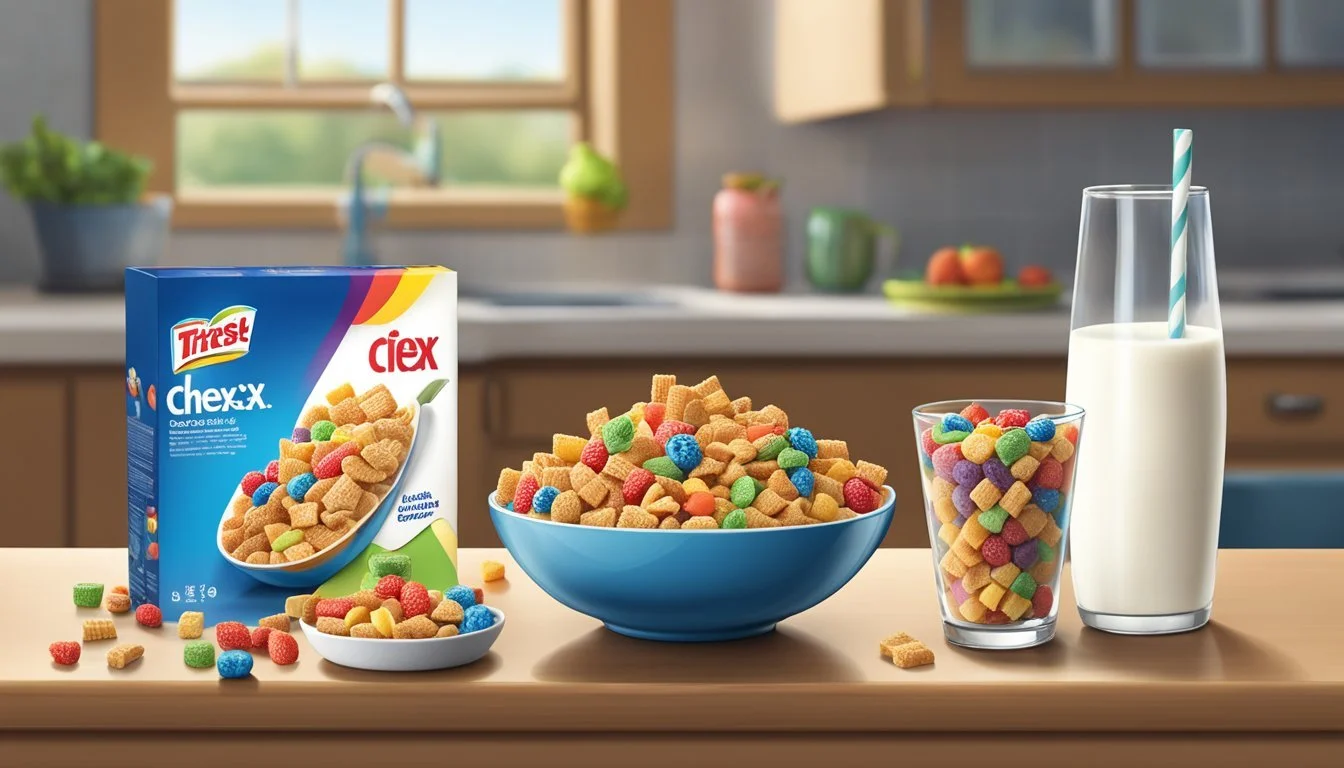Chex vs Trix
Comparing Popular Breakfast Cereals
This Article is Part of Our Breakfast Cereal Guide with Details on Chex Nutrition and Trix Nutrition
When choosing between Chex and Trix for a healthy breakfast, it's essential to consider their nutritional profiles. Chex, particularly Wheat Chex, offers a higher amount of complex carbohydrates compared to Trix, making it a more substantial choice for sustained energy. Wheat Chex contains 17.0 grams of complex carbohydrates per serving, while Trix has 13.0 grams. This difference could impact how full and energized one feels throughout the morning.
Taste is another significant factor. Trix, known for its vibrant colors and fruity taste, is a favorite among those who prefer a sweeter start to their day. Chex, particularly in its various flavors like Cinnamon Chex, provides a more subtle, yet satisfying crunch that can appeal to those who enjoy less sweetness.
When it comes to overall health, Chex takes a more favorable position. General Mills, the maker of both cereals, has ensured Wheat Chex contains lower sugar and higher fiber, which helps with digestion and maintaining stable blood sugar levels. Trix, on the other hand, is higher in sugar and lacks the fiber content that Chex offers, making it less ideal for those looking to maintain a balanced diet.
Historical Background
Chex and Trix are two iconic cereals with rich histories that reflect the evolution of American breakfast culture. Their development showcases various shifts in branding, ingredients, and consumer preferences.
Origins of Chex
Chex cereal, originally known as "Shredded Ralston," was introduced by the Ralston Purina Company in 1937. The square-shaped cereal quickly gained popularity due to its simplicity and nutritional value. The product was rebranded as Chex in 1950 to create a more catchy name and brand identity.
Wheat Chex and Rice Chex were the initial variants, contributing to a balanced diet with their whole grain content. General Mills acquired Chex in 1997, further diversifying the product line by launching flavors like Corn Chex and Honey Nut Chex. Chex Mix, a popular snack mix, also emerged from this versatile cereal, broadening its market reach.
Evolution of Trix
Introduced by General Mills in 1954, Trix has been a staple of child-focused marketing. The cereal originally featured colorful, fruit-flavored, puffed corn pieces, which set it apart from more traditional choices. Its tagline, "Silly Rabbit, Trix are for kids," became iconic and reinforced the brand's playful image.
In 1991, Trix switched from spherical shapes to fruit shapes like berries, oranges, and lemons. This change was a significant marketing move, although it reverted to its original form in later years due to consumer demand. The Trix Rabbit, a cartoon character, has remained central to its advertising, symbolizing its appeal to younger audiences.
Each brand has undergone notable changes to adapt to evolving market trends and dietary preferences.
Ingredient Profile
When comparing Chex and Trix cereals, it's essential to look at their ingredient composition to understand their nutritional benefits and drawbacks. Each cereal has distinct features that cater to different dietary preferences.
Chex Ingredients
Chex cereals, especially the Wheat and Rice variants, are known for their simple and whole grain-based ingredient lists.
Whole Grain Content: Wheat Chex uses whole grain as its primary ingredient, offering a significant amount of complex carbohydrates and fiber.
Rice Variant: Rice Chex features rice as its main ingredient, providing a lighter, gluten-free option.
Added Nutrients: These cereals often include vitamins and minerals such as iron and B vitamins.
Minimal Additives: Chex generally avoids artificial colors and preservatives like BHT, making it a cleaner option for health-conscious consumers.
Overall, Chex focuses on providing a balanced nutritional profile with fewer additives.
Trix Composition
Trix cereal, known for its vibrant appearance and sweetness, has a different ingredient profile.
Primary Ingredients: The main components of Trix include corn-based ingredients.
Sugar Content: Trix contains more added sugars compared to Chex, contributing to its sweet flavor.
Artificial Additives: This cereal uses artificial colors to achieve its bright, multi-colored look.
Fortifications: Trix is fortified with vitamins and minerals, though the presence of added sugars and colors may be a concern for some consumers.
Preservatives: There are more preservatives in Trix to maintain its shelf stability.
Trix aims to appeal to children and those seeking a sweeter cereal choice, but it comes with more additives and sugars.
Nutritional Breakdown
This section provides a detailed comparison of the nutritional aspects of Chex and Trix cereals, focusing on their macronutrient and micronutrient content.
Analyzing Chex’s Nutritional Value
Chex cereal comes in various types, but one serving of Wheat Chex provides a baseline for comparison. A typical serving size of one cup of Wheat Chex contains 143 calories. The macronutrient breakdown reveals that Chex has 3% fat, 90% carbohydrates, and 7% protein.
In terms of specific figures, Wheat Chex contains 17.0 grams of complex carbohydrates, which makes it a high-carb option. The protein content is 2.0 grams per serving, and it also offers a notable amount of dietary fiber. Fiber is crucial for digestive health. Additionally, Chex cereals often include added vitamins and minerals like iron.
However, one should watch the sodium content in some Chex varieties, as it can be higher in options like Chex Mix. The micronutrient contributions can vary by flavor, so it’s essential to check the packaging for specific details.
Assessing Trix’s Nutritional Aspects
Trix cereal is known for its bright colors and fruity flavors. A typical serving size, which is one cup, contains approximately 120 calories. Trix has a higher sugar content compared to Chex, with 13 grams of complex carbohydrates, of which a considerable portion comes from sugars.
When evaluating protein content, Trix offers 2 grams of protein per serving, making it comparable to Chex in this regard. However, Trix is lower in dietary fiber, making it less beneficial for digestive health.
Additionally, Trix cereal contains micronutrients like iron and various vitamins added during processing. It’s essential to note that while the cereal is fortified, the levels and types of nutrients added can vary, influencing its overall nutritional contribution compared to the naturally occurring vitamins in whole grain options like Wheat Chex.
By focusing on these nutritional components, consumers can make informed decisions about which cereal best fits their dietary needs.
Health and Diet Considerations
When comparing Chex and Trix cereals, it's important to understand their impact on health and diet. Each offers distinct nutritional profiles that can influence dietary choices depending on individual health goals and needs.
Health Benefits of Chex
Chex cereal, particularly Wheat Chex, is noted for its high fiber content and whole grain composition. Whole grains are essential for a healthy diet as they can help improve digestive health and reduce the risk of chronic diseases.
Moreover, Wheat Chex is low in fat and a moderate-calorie option, which makes it a good choice for those looking to manage weight. It is also fortified with vitamins and minerals, contributing to overall nutrient intake and potentially helping prevent micronutrient deficiencies.
The cereal's low sugar content adds to its appeal, especially for individuals aiming to maintain stable blood sugar levels. However, it’s important to note the moderate sodium content, which may require caution for those managing hypertension or other heart-related issues.
Dietary Impact of Trix
Trix cereal, while colorful and appealing, presents different dietary considerations. It is higher in sugar and lower in fiber compared to Chex, which can affect satiety and long-term energy levels. Less fiber means it may not keep you full as long and could lead to increased hunger between meals.
Trix was previously reformulated to remove artificial colors and flavors but has reverted due to public demand. This reintroduction of artificial ingredients might be a concern for those interested in a more natural diet.
On the nutritional front, Trix offers fewer whole grains and more simple carbohydrates. This composition may lead to quicker spikes in blood sugar followed by potential drops in energy. For a healthier breakfast choice, individuals might prefer cereals with reduced sugar and higher fiber content.
By examining these factors, readers can make more informed decisions based on their health goals and dietary preferences.
Consumer Preferences and Trends
Chex and Trix appeal to different consumer segments due to their distinct characteristics. As health consciousness and taste preferences vary among consumers, these cereals offer unique advantages.
Why Some People Choose Chex
Chex attracts consumers who prioritize nutrition and simplicity. Whole grain wheat provides a good source of fiber and essential nutrients. A standard serving contains 17.0 grams of complex carbohydrates, which aid in sustained energy release.
Several trends impact Chex's appeal. The focus on organic and health-conscious eating habits is significant. While Chex is not entirely organic, it aligns with a preference for minimally processed grains.
Brands like Kashi Golean Crunch! and Honey Almond Flax offer competition but Chex remains popular for straightforward ingredients. The absence of artificial colors and flavors is another plus, making it a preferred choice for those avoiding synthetic additives.
Trix and Its Colorful Appeal
Trix caters to those drawn to vibrant, fun cereals. With artificial colors creating its signature look, it stands out visually on shelves. It boasts a playful image that appeals particularly to children and the young at heart.
In terms of taste, Trix is known for its fruity flavors, appealing to those who prefer sweeter cereals. While it contains 13.0 grams of complex carbohydrates per serving, it tends to be favored more for its immediate sensory appeal than nutritional benefits.
Consumer preferences reveal that Trix's colorful appearance and sweet taste align with indulgent eating habits. Despite shifts towards healthy eating, a segment of consumers continues to choose Trix for its nostalgic and enjoyable eating experience.







